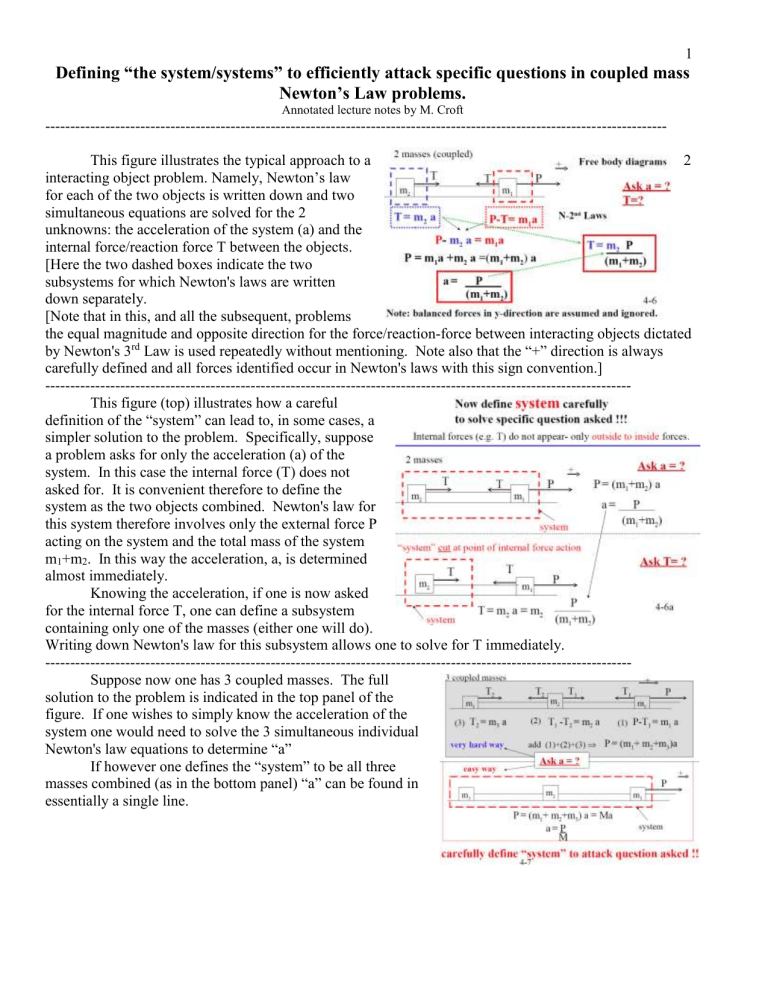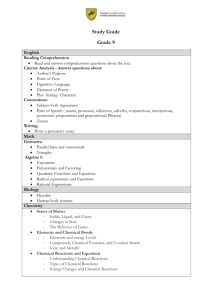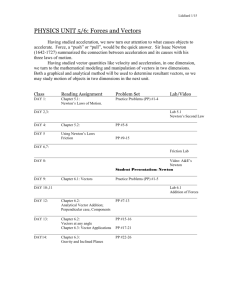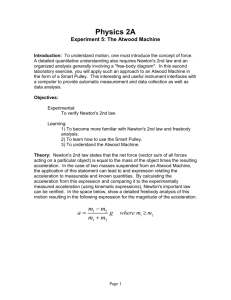This figure illustrates the typical approach to a 2 interacting object

1
Defining “the system/systems” to efficiently attack specific questions in coupled mass
Newton’s Law problems.
Annotated lecture notes by M. Croft
----------------------------------------------------------------------------------------------------------------------------
This figure illustrates the typical approach to a interacting object problem. Namely, Newton’s law for each of the two objects is written down and two simultaneous equations are solved for the 2 unknowns: the acceleration of the system (a) and the internal force/reaction force T between the objects.
2
[Here the two dashed boxes indicate the two subsystems for which Newton's laws are written down separately.
[Note that in this, and all the subsequent, problems the equal magnitude and opposite direction for the force/reaction-force between interacting objects dictated by Newton's 3 rd Law is used repeatedly without mentioning. Note also that the “+” direction is always carefully defined and all forces identified occur in Newton's laws with this sign convention.]
---------------------------------------------------------------------------------------------------------------------
This figure (top) illustrates how a careful definition of the “system” can lead to, in some cases, a simpler solution to the problem. Specifically, suppose a problem asks for only the acceleration (a) of the system. In this case the internal force (T) does not asked for. It is convenient therefore to define the system as the two objects combined. Newton's law for this system therefore involves only the external force P acting on the system and the total mass of the system m
1
+m
2
. In this way the acceleration, a, is determined almost immediately.
Knowing the acceleration, if one is now asked for the internal force T, one can define a subsystem containing only one of the masses (either one will do).
Writing down Newton's law for this subsystem allows one to solve for T immediately.
---------------------------------------------------------------------------------------------------------------------
Suppose now one has 3 coupled masses. The full solution to the problem is indicated in the top panel of the figure. If one wishes to simply know the acceleration of the system one would need to solve the 3 simultaneous individual
Newton's law equations to determine “a”
If however one defines the “system” to be all three masses combined (as in the bottom panel) “a” can be found in essentially a single line.
2
Having determined (or being given) “a” one can determine one of the internal forces (tensions T
1
, T
3
, or
T
3
) by creating a subsystem whose edge “cuts” the larger system at the point where the desired internal force “acts”
---------------------------------------------------------------------------------------------------------------------
This problem illustrates to coupled masses which are constrained to move linearly can be thought of as moving along a single “direction” as long as one carefully defines the + direction of motion consistently when going around a corner.
[Note that since the normal force N and gravitational force m
B g are perpendicular to the motion, and are balanced they are not included in the equations along the direction of motion.]
---------------------------------------------------------------------------------------------------------------------
This problem illustrates that the same definition of the system as both masses combined allows the determination of the acceleration, a, quickly despite the fact the system goes around the corner.
---------------------------------------------------------------------------------------------------------------------
This problem illustrates that the same concept
but with an additional mass.
3
---------------------------------------------------------------------------------------------------------------------
This problem illustrates that the same concept for a system that goes around two corners. It is especially important to carefully assign a + direction of motion that is consistent for all three masses.
Specifically, if m
A
moves upward, m
B
must move to the right, and m
C
must move down (i.e. the connecting ropes do not stretch or go slack).







